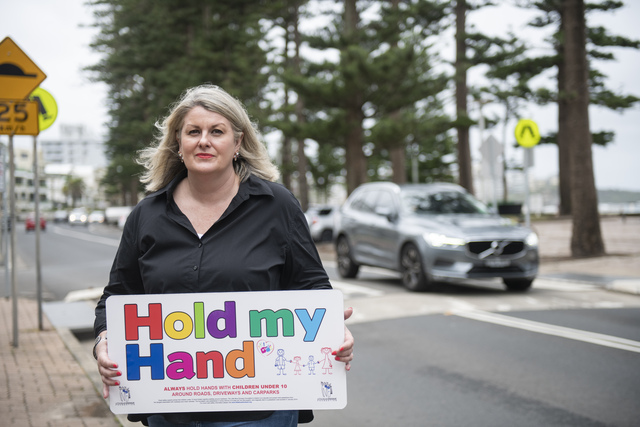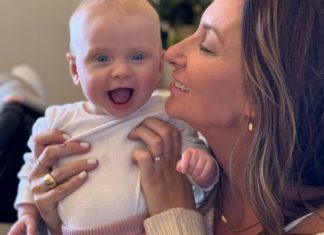By Casey Neill
At what age would you stop holding your child’s hand when crossing the street or walking through a car park?
Bereaved mother and road safety advocate Michelle McLaughlin says many parents are unaware that studies recommend hand-holding up to age 10.
“Holding your child’s hand is as important as putting a seatbelt on them in the car,” she said.
“They lack peripheral vision, their hearing isn’t great – they can’t discern where a vehicle’s coming from if they can’t see it.
“Their height restricts them from being seen by a driver.
“They’ve got slower reflexes – their brain and their body processes at a slower speed – so they keep taking those extra steps, which could put them in peril.”
Michelle’s son Tom stepped away from his family, onto the road, into the path of an oncoming car while on a holiday in January 2014. He died before help arrived.
“It was just really busy on that day; lots of parked cars on the street,” she said.
“Those towns are very quaint and beautiful, but they often lack infrastructure like curbs and gutters. It all played a part.
“I never for one moment imagined that our family would have to go through something like that.
“Little Blue Dinosaur, that’s been a healing entity for our family, and knowing that we’re doing all we can.”
Through the Little Blue Dinosaur Foundation (LBDF), Michelle has spent the past 10 years pushing to make Aussie roads safer for child pedestrians.
“The strong message that we really push is ‘hold my hand’ because since Tom’s accident, obviously we’ve been involved in a lot of research,” she said.
“We’ve done a two-year research pilot study looking into the causation of pedestrian deaths in Australia.”
They used 20 years of coronial data.
“Nothing’s changed there with the numbers,” Michelle said.
“It’s still one child every week dying in road trauma.
“That adds up to a lot of children every year.
“It leaves a massive impact on families long-term.
“You can’t ever find any justification in your mind because these are young, healthy, beautiful, vibrant children.
“They’re taken in a microsecond moment. It’s happening all too often.
“It’s the most stressful event that can take place in a person’s life, if they lose a child – in any circumstances, but particularly suddenly or traumatically.”
Her daughter, husband David, and in-laws witnessed the tragedy. Michelle was inside with her one-year-old son.
“We’ve really changed our whole life around since this tragedy happened,” she said.
“It affects your relationships, your daily responsibilities.
“Parents who go through this are at a higher risk of suicidal ideation, risk of alcohol and substance abuse, a lot of sleep disturbance from the trauma of having gone through an event like that.
“The other impact is marriage breakdown.”
Losing a child also hits families financially, including long-term counselling and other medical bills.
“People can’t necessarily immediately go back to work,” Michelle said.
“My husband had a lot of trouble concentrating at work.
“His business declined significantly for two years.
“I had been a nurse but I couldn’t go back and work in a high-stress environment anymore.
“I went into a hole and just managed looking after my baby boy and picking my daughter up from school.
“People keep away because they don’t want to disturb you. Yet you need all those little helping hands.”
Michelle said LBDF and Macquarie University studied the support services available for families who’d lost a child to road trauma.
“We’re really lacking practical assistance,” she said.
“Specialised support programs should be investigated.
“For 10 years I’ve tried in earnest talking to various MPs.
“I walked 10 kilometres in a day around Parliament House.
“There needs to be more action than just words from politicians and government.
“We try to advocate strongly on the research front and on the community awareness side.
“I wrote a book called Tom’s Holiday for the preschoolers.
“In the back of the book I made sure that it had educational information for parents.”
LBDF has also worked with 76 of Australia’s 537 local government areas to install colourful safety signage around playgrounds and busy roads and deliver education in preschools.
“If it could run in every LGA I think it would help and be impactful in preventing child road deaths,” Michelle said.
“Our studies show educational interventions like LBDF safety signage increase awareness of child pedestrian safety in the community.”
The talks in kinders include education on different types of roadways.
“I don’t even think in some of these places that children recognise them as roads,” she said.
“Discuss one aspect of road safety with your child every single day.
“Eventually it will sink in and stick.”
For more information on The Little Blue Dinosaur Foundation or to make a tax-deductible donation, visit www.littlebluedinosaur.org.









